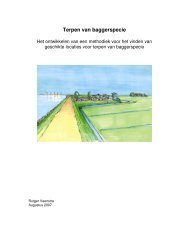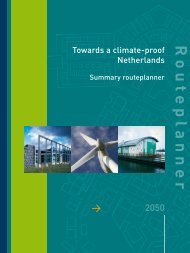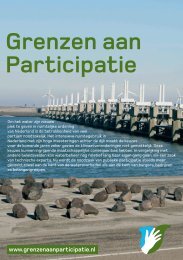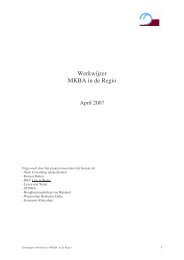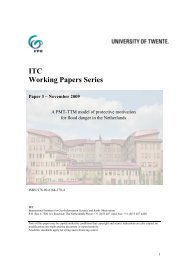Deltas on the move; Making deltas cope with the effects of climate c
Deltas on the move; Making deltas cope with the effects of climate c
Deltas on the move; Making deltas cope with the effects of climate c
- No tags were found...
You also want an ePaper? Increase the reach of your titles
YUMPU automatically turns print PDFs into web optimized ePapers that Google loves.
KvR report 001/2006<str<strong>on</strong>g>Deltas</str<strong>on</strong>g> <strong>on</strong> <strong>the</strong> <strong>move</strong>Opti<strong>on</strong>al: Should you wish to make more analysis in Excel, you can also click <strong>the</strong>download butt<strong>on</strong>. This will allow you to download <strong>the</strong> full excel database <strong>on</strong> your PC.Figure 6.7:Ranking <strong>of</strong> <strong>deltas</strong> for physical vulnerability based <strong>on</strong>1/100 yr surge height.Step 5) You can close <strong>the</strong> applicati<strong>on</strong> by closing <strong>the</strong> DELTAS browser window.Check it out at http://ivm10.ivm.vu.nl/<strong>deltas</strong>,<strong>the</strong> interactive <strong>on</strong>-line system for innovative delta management!6.3 Ranking <strong>of</strong> <strong>deltas</strong>, an illustrati<strong>on</strong>The DELTAS system produces a ranking <strong>of</strong> <strong>deltas</strong> for indicators according tophysical vulnerability, for stock at risk, and potential for s<strong>of</strong>t measures (Table 5.4).Specific indicators depict <strong>the</strong> different categories <strong>of</strong> system-based s<strong>of</strong>t approaches.The next secti<strong>on</strong>s aim to show how <strong>the</strong>se rankings should be interpreted, and how<strong>the</strong>y can be used for innovative system-based delta management.Physical vulnerabilityBoth <strong>the</strong> <strong>on</strong>e in a hundred year surge height and <strong>the</strong> area between 0 and 2 m abovemean sea level were identified as prime indicators for physical vulnerability inChapter 5. The latter is also c<strong>on</strong>sidered useful to indicate <strong>the</strong> overall potential for s<strong>of</strong>tsystem-based approaches. Some <strong>deltas</strong> are located in areas <strong>of</strong> high surge (listingbelow and Figure 6.7), whereas o<strong>the</strong>rs discharge in quieter seas.The following <strong>deltas</strong> are found in high surge regi<strong>on</strong>s:1. Lena;2. Mek<strong>on</strong>g;3. Fraser;4. Fly;5. Ganges-Brahmaputra.The o<strong>the</strong>r indicator, area between 0 and 2 m, is important because larger coastalplains <strong>with</strong> low storm surges, such as Yuk<strong>on</strong>, Mackenzie and Mississippi areprobably less vulnerable. These examples show that, depending <strong>on</strong> <strong>the</strong> c<strong>on</strong>text,more than <strong>on</strong>e indicator should be c<strong>on</strong>sidered. The DELTAS system <strong>of</strong>fers thispossibility. When in doubt, we suggest that here you adhere <strong>the</strong> precauti<strong>on</strong>aryprinciple and c<strong>on</strong>sider high-ranking <strong>deltas</strong> for both indicators to be very vulnerable.LenaMek<strong>on</strong>gFrazerFlyGanges-ZambeziRedChao PhrayaMangokyIndusBurdekinOrinocoParanaMahakamYangtze-KiangMahanadiShatt el ArabPoHuang HeIrrawaddyDneiperGodavariMississippiSao FranciscoKrishnaMacKenzieYuk<strong>on</strong>PechoraSenegalNigerDanubeEbroNileMagdalena0 1 2 3 4 5 6 71/100 yr surge height (m)Stock at riskThe next five <strong>deltas</strong> have a particularly high stock at risk (when using peoplepotentially flooded in 2000 as an indicator for stock at risk):1. Ganges-Brahmaputra;2. Chao Phraya;3. Godavari;4. Krishna;5. Mahanadi.The first thing to notice is that <strong>the</strong>se five <strong>deltas</strong> are all Asian. If we, subsequently,compare this ranking to <strong>the</strong> <strong>on</strong>e for physical vulnerability, we are fortunate that <strong>on</strong>ly<strong>the</strong> Ganges-Brahmaputra ranks high in both lists, and is <strong>the</strong>refore both physicallyvulnerable and has a high stock at risk. This delta, which is <strong>on</strong>e <strong>of</strong> <strong>the</strong> largest in <strong>the</strong>world, covers some 105.640 km 2 and has <strong>on</strong>e <strong>of</strong> <strong>the</strong> highest populati<strong>on</strong> densities <strong>of</strong>all <strong>deltas</strong>, and c<strong>on</strong>sequently DIVA gives a relatively high number <strong>of</strong> peoplespotentially flooded (Figure 6.8). The major river floods occur during <strong>the</strong> m<strong>on</strong>ths fromJune through September (Coleman & Huh, 2004). The inland part <strong>of</strong> <strong>the</strong> tidal plainhas been reclaimed, and <strong>the</strong> former saline lands have been c<strong>on</strong>verted to variousagricultural and marine farming practices (see also Secti<strong>on</strong> 7.3.)6061



